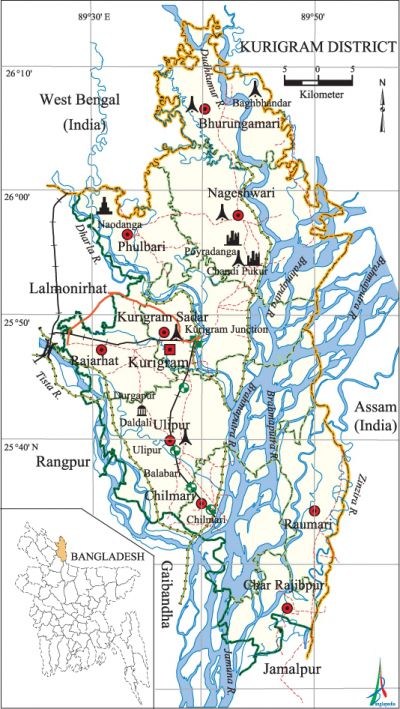Kurigram District
Kurigram District (rangpur division) area 2245.04 sq km, located in between 25°23' and 26°14' north latitudes and in between 89°27' and 89°54' east longitudes. It is bounded by west bengal state of India on the north, gaibandha and jamalpur districts on the south, assam state of India on the east, West Bengal of India, rangpur and lalmonirhat districts on the west.
Population Total 2069273; male 1010442, female 1058831; Muslim 1932779, Hindu 135484, Buddhist 48, Christian 103 and others 859.
Water bodies Main rivers: brahmaputra, jamuna, dharla, dudhkumar, tista, Zinzira; Chakir Posar Beel is notable.
Administration Kurigram Sub Division was formed in 1874 and it was turned into a district in 1984. Kurigram Municipality was formed in 1972. The district has 14 enclaves. Of the 9 upazilas of the district ulipur is the largest (504.19 sq km, it occupies 22% of the total area of the district) and char rajibpur is the smallest (111.03 sq km).
| District | |||||||||
| Area (sq km) | Upazila | Municipality | Union | Mouza | Village | Population | Density (per sq km) | Literacy rate (%) | |
| Urban | Rural | ||||||||
| 2245.04 | 9 | 3 | 72 | 600 | 1872 | 326494 | 1742779 | 922 | 42.5 |
| Others Information of District | |||||||||
| Name of Upazila | Area (sq km) |
Municipality | Union | Mouza | Village | Population | Density (per sq km) |
Literacy rate (%) | |
| ulipur | 458.48 | 1 | 13 | 134 | 354 | 395207 | 862 | 45.6 | |
| kurigram sadar | 276.43 | 1 | 8 | 76 | 266 | 312408 | 1130 | 46.1 | |
| char rajibpur | 111.03 | - | 3 | 26 | 99 | 73373 | 661 | 36.5 | |
| chilmari | 224.96 | - | 6 | 48 | 133 | 122841 | 546 | 39.7 | |
| nageshwari | 417.56 | 1 | 14 | 73 | 350 | 394258 | 944 | 38.7 | |
| phulbari | 156.61 | - | 6 | 48 | 166 | 160250 | 1023 | 44.8 | |
| bhurungamari | 236.26 | - | 10 | 56 | 126 | 231538 | 980 | 39.6 | |
| rajarhat | 166.64 | - | 7 | 110 | 180 | 182981 | 1098 | 52.0 | |
| raumari | 197.03 | - | 5 | 29 | 198 | 196417 | 997 | 34.6 | |
Source Bangladesh Population Census 2011, Bangladesh Bureau of Statistics.
War of Liberation In 1971, the freedom fighters attacked a military convoy at a place near the Chaumoni Bazar of Ulipur upazila. On 20 May the Pak army brutally killed about 30 persons of Chilmari upazila at a place on the bank of the Brahmaputra. On 11 November, 69 members of the allied forced including Major Ram Singha and 5 freedom fighters were killed in a battle with the Pak army in Bhurungamari upazila of the district. On 13 November the Pak army brutally killed about 700 innocent people at Hatia of Ulipur upazila. Besides, an encounter was held between the freedom fighters and the Pak army on 19 November near the Royganj Bridge of Nageshwari upazila in which three freedom fighters including Lt. Col. Samad were killed. Another battle was held between the freedom fighters and the Pak army on 20 November in Bhurungamari upazila in which more than 100 Pak soldiers were killed and so were a number of freedom fighters including Lt. Abu Saiyed Mohammad Ashfaqus Samad (Bir Uttam). The Pak army killed 62 persons of Nilur Khamar Mouza under Santoshpur union of Nageshwari upazila. Besides, they also burned to death 35 persons at a place on the north-west side of the Nageshwari Health Complex. There are mass grave at 11 places of different upazilas of the district (Nageshwari, Bhurungamari, Ulipur and Kurigram Sadar upazila) and mass killing sites at two places (Bhurungamari and Chilmari upazila). Four memorial monuments, a martyr memorial plate (at Ghosh Para) and a victory pillar (at the college turning point of the town road).

Literacy rate and educational institutions Average literacy 42.5%; male 46.5%, female 38.8%. Noted educational institutions: Ulipur Maharani Sarnamoye High School and College (1868), Kurigram Government College (1961), Ulipur Government Degree College (1964), Bhurungamari Degree College (1967), Mir Ismail Hossian Degree College (1973), Phulbari Degree College (1973), Raumari Degree College (1979), Chilmari Degree College (1985), Rajibpur Degree College (1987), Kurigram Government High School (1895), Ulipur Government Girls' High School (1909), Durgapur High School (1914), Kurigram River View High School (1915), Naodanga High School (1919), Bhurungamari Pilot High School (1925), Kurigram Girls' High School (1928), Chilmari High School (1933), Pangarani Lakshmipriya High School (1939), Raumari Government Primary School (1898), Payardanga Government Primary School (1907), Nageshwari Alia Madrasa (1960), Kurigram Alia Madrasa (1967).
Main sources of income Agriculture 70.41%, non-agricultural labourer 4.74%, industry 0.51%, commerce 9.45%, transport and communication 2.02%, service 4.98%, construction 0.77%, religious service 0.15%, rent and remittance 0.21% and others 6.76%.
Newspapers and periodicals Daily: Chaoa Paoa, Jago bahe, Kurigram Khabor, Banglar Manush; weekly: Ganakatha, baher desh, Dudhkumar, Ganapran, Gramantar,' Julfikar; fortnightly: Dwip Desh, 'Bartabaha, Utshoo, Ayena; irregular: Uttar Chaiti,' Agradut.
Folk culture The distinctive folk culture of the district include Bhawaiya song, Palli geeti, Murshidi, Marfati, Baul song, marriage song, Chatka song, song of Bhanna Kushan, Goralir Panchali, Jari gan, rhymes, proverbs, folk tale, riddle, etc.
Tourists spots Dharla Bridge (Kurigram), Behular Char (Char Rajibpur), Ramna Ghat (Chilmari), Phulsagar (Phulbari), Naodanga Zamindar Bari (Phulbari), Bhitarbandh Zamindar Bari (Nageshwari), Chakir Poshar Beel (Rajarhat), Sindurmati Dighi (Rajarhat). [Md Kamal Hossain]
See also The upazilas under this district.
References Bangladesh Population Census 2001 and 2011, Bangladesh Bureau of Statistics; Cultural survey report of Kurigram District 2007; Cultural survey report of Upazilas of Kurigram District 2007.
